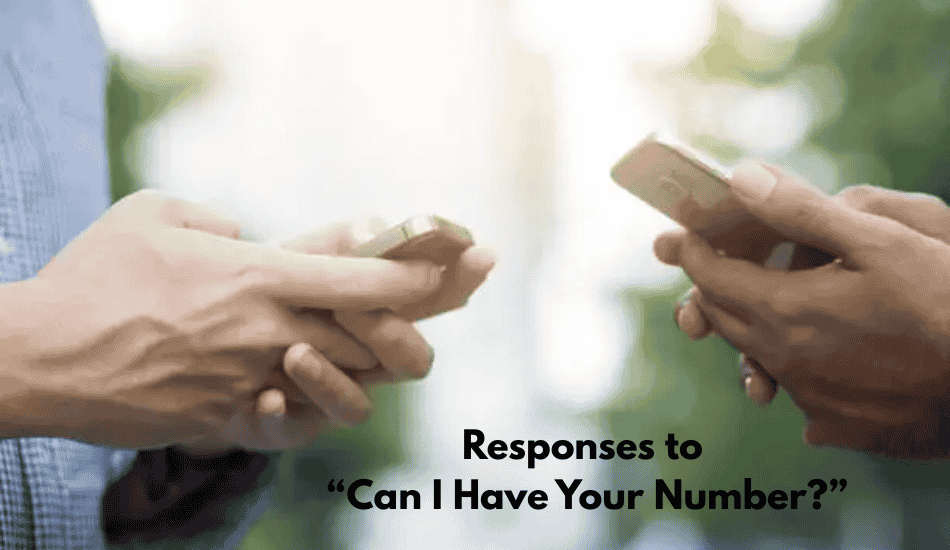When someone asks, “Can I have your number?” your response can set the tone for future interactions. Whether you’re open, hesitant, or simply uninterested, how you respond reveals a lot about your boundaries, comfort level, and communication style. Know Responses to “Can I Have Your Number?”. This guide includes over 200 categorised responses to help you navigate any situation—romantic, professional, playful, or cautious. Preparing the right response allows you to remain confident, clear, and kind no matter who asks.
Responses to “Can I Have Your Number?”
1. Direct Acceptance. (Open to sharing your phone number)
1. Here’s my number.
2. Let’s communicate through text.
3. Sure, here it is: 555-123-4567.
4. My number is 555-234-5678.
5. Not a problem! You can contact me at 555-345-6789.
6. I’d love to stay in touch. It’s 555-456-7890.
7. My number is 555-567-8901.
8. Feel free to text me at 555-678-9012.
9. You got it! 555-789-0123.
10. Text me later at 555-890-1234!
11. You can contact me at 555-901-2345.
12. Thanks for asking! My number is 555-012-3456.
13. For further discussion, please call 555-098-7654.
14. Call 555-876-5432 and don’t be a stranger.
15. I’m fine with that. Here’s my number.
16. Please contact me using the information provided below.
17. What are my digits? 555-777-8888 — text away!
18. Contact me at 555-666-9999.
19. We are now connected at 555-111-2222.
20. Call 555-333-4444.
2. Polite Decline (Soft refusals with respect)
21. I prefer to keep my number private.
22. While I appreciate the compliment, I am hesitant to share my phone number.
Thank you, but I prefer not to share my phone number.
24. I appreciate it, but I don’t feel comfortable sharing it.
25. I want to keep my contact information private.
26. I appreciate the request, but I will decline.
27. Please understand that I keep my phone number personal.
28. Please understand, but I do not share my phone number.
29. I’m not ready to share my phone number.
30. I prefer not to, but appreciate the request.
31. I usually only share my phone number with family and close friends.
32. I appreciate your request, but I regret to decline.
33. I’m not sharing numbers these days.
34. I’m keeping my phone quiet for now.
35. Thank you for asking; perhaps another time.
Know Best Responses to “Thinking of You”.
3. Indirect Refusal or Evasive Responses
36. I’d be happy to talk here for now.
37. I typically avoid giving out my phone number to new acquaintances.
38. Let’s discuss more before exchanging numbers.
39. Perhaps another time?
40. I am still getting to know you.
41. Let’s discuss further and revisit this later.
42. Allow me to think about it.
43. Can we discuss this further before I make a decision?
44. I’m not ready to share my number.
45. I prefer taking slow steps when sharing personal information.
46. Can’t we get to know each other better first?
47. I would like to continue chatting here.
48. I am not in the mood to share numbers today.
49. Let’s see how things go before exchanging numbers.
50. I’m not sure; ask me later.
4. Provide an alternative contact method
51. Let’s connect through LinkedIn instead.
52. How about exchanging emails?
53. Message me on Instagram.
54. I am more active on Twitter.
55. What about Facebook Messenger?
56. Snapchat works better for me.
57. I prefer email for initial contact.
58. Do you have Discord?
59. Let’s chat via WhatsApp.
60. I will share my Telegram handle instead.
61. I’d rather communicate via Messenger.
62. TikTok Direct Messages work better for me.
63. I’m more accessible on Reddit.
64. Join me on Clubhouse for a chat.
65. We can connect using Pinterest messages.
5. Humorous or playful responses.
66. It’s 867-5309. Just kidding!
67. Promise not to text me at 3 a.m.!
68. However, it self-destructs after three uses.
69. You must first win a game against me!
70. Are you prepared for daily cat memes?
71. I could give it to you, but it would mean deleting you.
72. Could I give you my lawyer’s number instead?
73. Yes, but it’s 1-800-GOOD-LUCK.
74. Only if you solve three riddles!
75. 404-ERROR-LOL.
76. I lost it during a game of Monopoly.
77. I’ve written it in invisible ink.
78. Correct guesses only!
79. Ready for Morse code?
80. I will consult the stars first.
6. Conditional acceptance.
81. I will give you my phone number if we meet again.
82. Let’s talk more first, then I’ll share it.
83. Possibly after additional conversations.
84. Let me get to know you better.
85. Let’s go for coffee first, and then I’ll decide.
86. I’ll share it next time if we get along well.
87. If the conversation continues to be positive, I will consider it.
88. After a few hangouts.
89. I’d rather wait until we know each other.
90. I may share it in the future.
91. If we meet again, maybe.
92. After seeing your karaoke skills.
93. Can you remember my favourite colour?
94. If the conversation goes well, we’ll see.
95. Keep the positive vibes going first.
7. Refusing or setting boundaries
96. I’m not willing to share my number.
97. I keep my contact information private.
98. I do not share my phone number.
99. This is against my personal policy.
100. I’m setting boundaries for personal comfort.
101. I don’t think it’s appropriate now.
102. I’d prefer not to.
103. I keep my phone number very private.
104. This number is only for close connections.
105. Due to previous issues, I refrain from sharing this information.
106. I am concerned about my privacy.
107. I do not use my phone for social interactions.
108. I decline.
109. I prefer to keep my circle small.
110. I have strict rules regarding personal information.
8. Professional/business-oriented responses.
111. Please find attached my business card with contact information.
112. Please email my office instead.
113. I keep my personal and professional contacts separate.
114. My work number is ideal for this.
115. Let’s connect via LinkedIn.
116. Email is more appropriate for this situation.
117. I do not use personal numbers at work.
118. I can connect you with my assistant.
119. Call my office line during business hours.
120. My company profile shows that I am available.
121. Let’s communicate through our teams.
122. WhatsApp for my business is now available.
123. Find me on my firm’s website.
124. For better communication, please email me at work.
125. I maintain strict separation between my work and personal lives.
9. Focus on Privacy and Safety
126. Due to privacy concerns, I do not share my phone number.
127. I prefer to remain anonymous.
128. I have had negative experiences in the past.
129. My privacy is crucial to me.
130. I safeguard my personal information.
131. It is a security issue.
132. I only share my phone number with close friends.
133. I’d rather keep that information private.
134. For safety reasons, I do not.
135. I adhere to my personal boundaries.
136. I have learnt to be cautious online.
137. I avoid using numbers for inappropriate purposes.
138. I’m being more cautious these days.
139. I’ve experienced spam issues before.
140. I maintain a digital boundary.
10. Use apps or secondary numbers.
141. Let’s talk via WhatsApp.
142. I use Google Voice for new contacts.
143. This is my secondary phone number.
144. Add me in Telegram.
145. I prefer Signal for privacy.
146. Use the app-specific number.
147: I use a burner number.
148. Add me on WeChat.
149. I keep my main phone number private.
150. This app helps me keep things separate.
151. Let’s chat via Viber instead.
152. Use Skype to contact me.
153. My phone number is only available through the app.
154. I created a temporary number for similar situations.
155. You can reach me via VoIP.
11. Deflection with a Question
156. Can you tell me why you want my number?
157. What will it be used for?
158. Can you tell me what you need it for?
159. Isn’t social media easier?
160. Do you feel comfortable sharing yours first?
161: Why do you prefer texting?
162. Do you always ask for people’s phone numbers?
163. What is your reason for staying in touch?
164. What are your intentions here?
165. Is there another option you would be comfortable with?
166. What kind of conversations are you expecting?
167. Why not discuss here instead?
168. How can I trust you?
169. Can we wait to meet again?
170. Why are you asking now?
12. Role-playing / Nonverbal Communication
171. Passes a business card silently.
172. Writes email address on a serviette.
173. Offers QR code.
174. Refers to Instagram handle.
175. Nods to a mutual friend.
176. Provides pre-written contact on paper.
177. Displays a polite smile and ‘no’ gesture.
178. Displays phone numbers and allows users to enter their own.
179. Provides a sticker with contact information.
180. Plans to connect online later.
181. Hands over a note with an alternative ID.
182. Shrugs and moves away from the phone.
183. Taps smartwatch and shakes head.
184. Uses eye contact to convey uncertainty.
185. Types and holds phone.
Know Beautiful Responses to “You’re Making Me Blush”.
13. Cultural or contextual considerations.
186. In my culture, numbers are rarely shared quickly.
187. I prefer to take it slow when making new connections.
188. I don’t usually share numbers this early.
189. I prefer mutual introductions first.
190. I only provide my number after several meetings.
191. This is not something I do during the first encounter.
192. Let’s connect more through mutual friends.
193. I have a cultural tendency to prioritise online activities.
194. I prefer to establish a rapport first.
195. My circle connects primarily through social media.
196. My family taught me to be cautious.
197. We are advised not to rush into contact-sharing.
198. My friends and I primarily communicate via email.
199. I’ve always preferred moving slowly.
200. I honour personal traditions here.
FAQs
Q1. What is the importance of having a prepared response to the question “Can I have your phone number?”
A thoughtful response allows you to maintain control of the conversation and communicate your level of comfort without feeling awkward or pressured.
Q2. What if I want to stay in touch but don’t want to share my phone number right away?
To stay in touch without compromising your privacy, use one of the alternative contact methods, such as social media or email.
Q3: Can these responses be used in professional settings?
Yes! We’ve included a comprehensive list of business-appropriate responses that maintain professionalism while establishing boundaries.
Q4. How can I decline politely without hurting the other person’s feelings?
Use responses from the “Polite Decline” or “Indirect Refusal” categories; they allow you to say no while remaining kind and respectful.
Q5. Are there any funny responses that will not come across as rude?
Definitely! The “Humorous or Playful” category contains light-hearted responses that entertain without being dismissive.
Conclusion
Saying “yes,” “no,” or “not yet” to requests like “Can I have your number?” does not have to be awkward or uncomfortable. With over 200 customisable replies organised by tone and context, you can now respond in a way that reflects your comfort, intent, and style. Whether you’re protecting your privacy, setting boundaries, or willing to connect, your response is your right. Maintain your confidence, clarity, and personal integrity.


